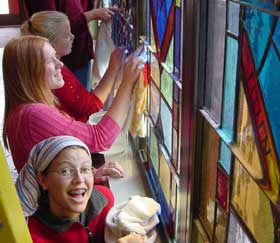Completed in 2002, Saint George's
stained glass windows are inspired
by the hymn
"I
Sing a Song of the Saints of God,"
and reflect almost four years of
planning, research and fabrication.
They replace the crumbling and
leaking original windows from 1964
which had more than lived out their
expected 30 year life span.
The Saint George window in the
narthex contains pieces of these
original windows in the red cross
of George's banner. Red is
the most precious color of glass as
its hue is achieved by the
incorporation of gold dust within
the melted glass.
Saint
George's windows are called
"antique" glass (meaning new glass
but hand blown by the traditional
method) held in place by lead
framing, protected by double panes
of thermal glass on the exterior of
the building. In years to
come, the leading can be repaired
and replaced making the life
expectancy of these windows beyond
calculation.
The
fabrication process of stained
glass is complicated and
fascinating. After numerous
renderings on paper, a design is
finally agreed upon and the
"blueprint" of the window is laid
out. Every piece of glass is
hand selected, then painted and
fired in a kiln utilizing a variety
of chemicals to permanently change
its appearance. The glass is
held in position first by wax and
then lead as the window reaches its
completed form. Structural
bars are added for reinforcement
and finally the windows are crated
and shipped to their destination.
Designed by artist Joan Collins of
Willet Studios in
Philadelphia, one of the oldest
glass studios in America, Saint
George's windows depict saints and
historical figures which tell the
story of God's call to people
throughout human history. The
light from the pictures of these
faithful people rests on the faces
of countless worshippers to today -
each struggling in their own way to
be followers and present day
disciples of Jesus Christ.
The Tradition of Stained Glass
From
the flickering of fire on cave
walls to the glow of computer
monitors, the human imagination is
captivated by the play of light.
The art of coloring glass to
reflect that light dates back to
the tenth and eleventh centuries
and may have been inspired by the
use of alabaster in windows around
the Mediterranean.
Canterbury
Cathedral in England
holds windows that date back to the
14th Century -- indicative of the
wide use of the medium by church
builders throughout history.
The oldest fragments of stained
glass in existence today depict the
face of Christ and are found in
Lorsch
and Wissemburg.
The
highest form of this art was
achieved by craftsmen of gothic
cathedrals and perhaps best
represented in the great explosions
of color known as "rose" windows --
often located on the west and east
walls in direct line with the
sunlight. Here the beholder
may sometimes experience the veil
between heaven and earth become
transparent -- and feel the wonder
its designers intended -- a soul
that has come into the Presence of
the Divine.
Continuing in this ancient
tradition, Saint George's windows
are not only objects of art but of
inspiration -- truly a gift of
beauty and faith to the greater
Dayton community.




